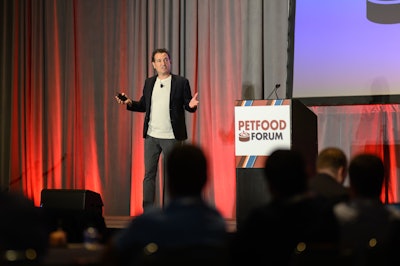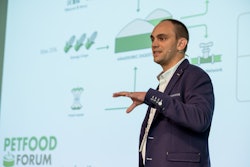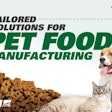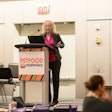
Author of more than 20 best-selling books and regular TV and radio guest, Daniel Levine, director of the Avant-Guide Institute, a New York-based trends consultancy, provided insights to guide pet food producers and professionals in understanding approaching trends to turbocharge their innovation during his keynote address at the opening session of Petfood Forum 2024 in Kansas City on April 30.
Levine shared his insights into mindsight trends shaping the pet food space, noting that understanding these movements can help guide your business into the right direction. Unlike fads, which shouldn’t be used to make business decisions, trends are valuable to study.
“Mindset trends are measurable changes in sentiment in any direction,” explained Levine. “These are moments when customers start to think a certain way or move down a certain track. Some of these might seem recognizable. That’s why they’re trends – they’re already in motion.”
His session, Barking up the right tree: How consumers, culture and technology are changing the way people will feed their pets, focused on six areas: Peoplefood Trends, Functionality, Transparency, Humanization, Convenience and Technology.
1. Peoplefood Trends
In the pet space, peoplefood trends impact a lot of what’s happening. Trends are not siloed by an industry, said Levine. They often cross over into every area of life.
“We’re seeing more humans blurring the lines between what’s a meal and what’s a snack,” said Levine. “With humans, we’re seeing a surge in individually packaged snacks. Because trends grow, we can expect snacking for pets to grow as well.”
For humans, single-serve snack food packaging is large and growing, which means single-serve pet food packaging will also grow. “Humans like to interact with their pets like they’re other humans,” noted Levine.
Another peoplefood trend Levine noted was increased water consumption. From “super waters” with functional benefits and even water concierges at high-end restaurants that pair your meal with the best water, people are experiencing water at whole new levels, and you can expect consumers will want to share that experience with their pets as well.
2. Functionality
The functionality mindset trend dovetails with human market, with a blurring of pet and human markets, and is intensifying, said Levine.
“The functionality trend has a lot of inertia and is growing,” said Levine. “It will be far bigger in a few years then it is now. Like other trends, it will keep growing until something stops it.”
Functional products include a focus on digestion aids with pre- and probiotics, CDB products for calming and relieving anxiety, functional drinks that provide vitamins, and the Blue Zone concept.
“Blue Zones” are geographic areas with lower rates of chronic diseases and a longer life expectancy,” said Levine. “There are now meals people can buy that are associated with the Blue Zones, and I expect the same concept to move over to the pet food market.”
3. Transparency
“Customers are talking about us, and with the advent of social media, can now see through us,” said Levine. “People want to see what they’re getting and what they’re buying. Transparency equals trust. Social media keeps companies honest.”
How can you be clearer with your customers? Packaging is one place to “show not tell” what your company is about or what it offers.
“People want sustainability – so now companies are being very clear about what they offer on their packaging in the way of a ‘sustainability facts’ box,” he said.
How are you being socially responsible? Use a QR code on your packaging to help customers trace how the product came through the supply chain from start to finish. Or tell them how to recycle the package to make it easy for them to do, for example, “recycle with paper.”
4. Humanification
Humanization, or as Levine calls it “humanification,” involves pet owners treating their companion animals like themselves and can be seen in many layers of the pet space.
“We know this humanification trend is sticking – and growing – because we’re seeing it globally in lots of cultures,” said Levine.
Examples of products appealing to this mindset trend include arctic char toppers that offer “human-grade fish made in human-grade factories,” non-dairy “yogurt,” sushi recipes, vegetarian burrito bowls and even “coffee” – all for dogs.
Another example of humanization is the human food companies entering the pet food space. Levine noted Joe’s Craft Soda now has a beef and turkey & gravy flavored soda for dogs, and Anheuser-Busch offers a Dog Brew.
5. Convenience
Despite the promise of technology to make our lives easier, we just keep getting busier. The convenience mindset trend is driven by humans wanting companies to help make their lives move a little more smoothly.
“Technology was supposed to allow us to relax, but now we can get more done in less time,” noted Levine. “Companies are saying – let us make it easier and faster for you to do business with us.”
Examples he used were Amazon’s One-Click shopping option and Domino’s “zero click” ordering. Companies are also pumping up their website FAQ pages to give customers the tools to answer questions themselves.
6. Technology
Technology moves fast and is embraced quickly, said Levine. In the next five years, we’ll see more technology introduced and accepted than we did in the last five years. He cited four technologies that will impact the pet space:
- High-end appliances for making pet foods will invite customers to make food on their own counters. “I don’t see these taking down the pet food industry at $600 apiece, but it might impact the super-premium pet food space,” he said.
- Lab-grown meats will grow in the pet space before the human space. Humans are too picky and will need cultured meat to taste and feel like meat, whereas pets are more accepting. A few brands have entered the pet food arena already, but that will continue to grow.
- AI will continue to find more uses in pet nutrition. One company, Side-by-Side, offers custom-created formulas based off analyzing your dog’s tongue via a picture.
- Ozempic, which we know has already impacted the way people think about their food and how they eat, will also change the pet food space. “It’s easy to imagine these types of drugs will be changing the pet space,” said Levine, noting vets are prescribing off-label Ozempic for some pets already.
“Mindset trends are important to pay attention to,” said Levine. “Pet food is more than feeding pets. These trends are relevant because you, as a pet food producer, get to help people meaningfully impact their lives.”
As Levine concluded, using Charles Darwin as inspiration, it’s not the largest or strongest who survive in the world, but knowing the trends can help you to be malleable and innovate.
Daniel Levine operates the Avant-Guide Institute New York-based trends consultancy and works with many companies, including McDonald’s, American Express, Microsoft and Dior, to help them anticipate the coming trends that could most affect their businesses. He leads a large team of trendspotters who track the latest ideas and experiences around the globe.


















